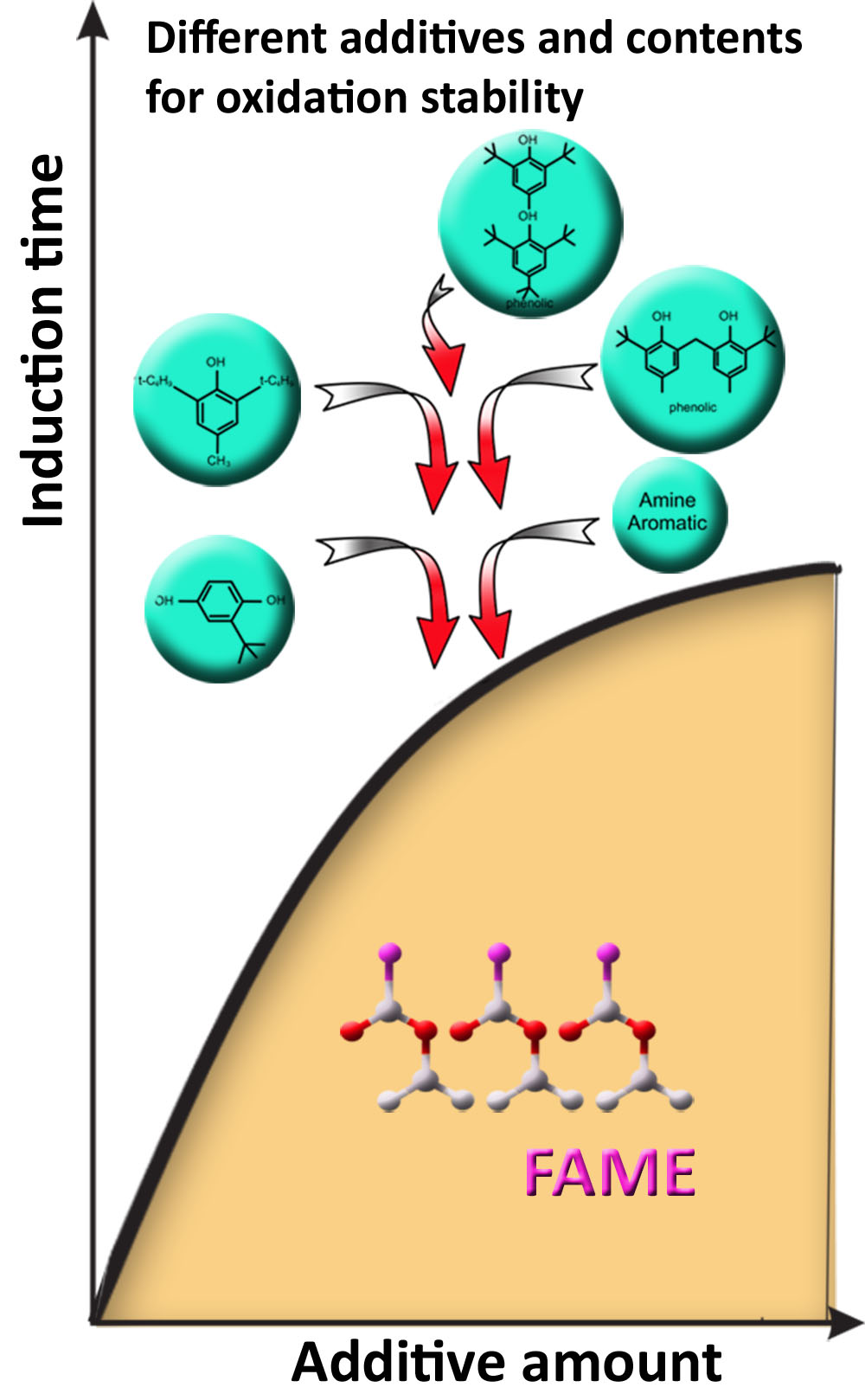Efficiency of different additives in the improvement of the oxidation stability of fatty acid methyl esters with different properties Scientific paper
Main Article Content
Abstract
This study evaluates six formulations in improving the oxidation stability of different fatty acid methyl esters (MEs). Two MEs differed in the unsaturation levels as they were synthesized from different feedstock: a blend of soybean and sunflower oils, and waste cooking oil; they did not fulfill the requirements of the EN 14214 standard concerning their oxidation stability (≈0.6 h) and some impurities. The third MEs (SoSuME-EN) were fully compliant with the standard. Five formulations were phenolic-based, containing single or mixed antioxidant compounds of different molecular structures; one was amine-based. Different dosages of the formulations were added to the ME samples (corresponding to the addition range 50–48300 ppm). The MEs stability expressed as induction periods, IP, determined by the Rancimat method, were used for the calculation of stabilization factors, SF, indicating the efficiency of the applied formulation. The formulation containing 2-(1,1-dimethylethyl)-1,4-benzenediol was the most efficient concerning the lowest consumption rate and the highest SF achieved for the low quality ME. 2,2′-Methylene-
-bis-(4-methyl-6-tert-butylphenol) was linked with higher antioxidant potency than the amine-based formulation and the phenolic compounds with two bulky tert-butyl groups. Among the 4 selected phenolic additives, butylated hydroxytoluene and 2,2′-methylene-bis-(4-methyl-6-tert-butylphenol) had similar efficiency in SoSuME-EN (at ≈500 ppm they produced SF ≈ 2), while it took twice of this amount for mixed butylphenols to achieve the same effect.
Downloads
Metrics
Article Details

This work is licensed under a Creative Commons Attribution-NonCommercial-NoDerivatives 4.0 International License.

Authors retain copyright and grant the journal right of first publication with the work simultaneously licensed under a Creative Commons Attribution license 4.0 that allows others to share the work with an acknowledgement of the work's authorship and initial publication in this journal.
References
M. Tomić, N. Đurišić-Mladenović, R. Mićić, M. Simikić, L. Savin, Fuel 235 (2019) 269 (https://doi.org/10.1016/j.fuel.2018.07.123)
M. J. Ramos, C. M. Fernández, A. Casas, L. Rodríguez, A. Pérez, Bioresour. Technol. 100 (2009) 261 (http://doi.org/10.1016/j.biortech.2008.06.039)
S. Jain, M. P. Sharma, Renew. Sustain. Energy Rev. 14 (2010) 667 (https://doi.org/10.1016/j.rser.2009.10.011)
G. Karavalakis, S. Stournas, Energy Fuels 24 (2010) 3682 (https://doi.org/10.1021/ef1004623)
S. Agarwal, S. Singhal, M. Singh, S. Arora, M. Tanwer, ACS Sustain. Chem. Eng. 6 (2018) 11036 (https://doi.org/10.1021/acssuschemeng.8b02523)
J. Pullen, K. Saeed, Renew. Sustain. Energy Rev. 16 (2012) 5924 (https://doi.org/10.1016/j.rser.2012.06.024)
Z. Yaakob, B. N. Narayanan, S. Padikkaparambil, K. Surya Unni, M. P. Akbar, Renew. Sustain. Energy Rev. 35 (2014) 136 (https://doi.org/10.1016/j.rser.2014.03.055)
R. Kumar Saluja, V. Kumar, R. Sham, Renew. Sustain. Energy Rev. 62 (2016) 866 (https://doi.org/10.1016/j.rser.2016.05.001)
M. M. Rashed, M. A. Kalam, H. H. Masjuki, H. K. Rashedul, A. M. Ashraful, I. Shancita, A. M. Ruhul, RSC Adv. 5 (2015) 36240 (https://doi.org/10.1039/C4RA14977G)
K. Varatharajan, D. S. Pushparani, Renew. Sustain. Energy Rev. 82 (2018) 2017 (https://doi.org/10.1016/j.rser.2017.07.020)
B. Chen, D. McClements, E. Decker, Crit. Rev. Food Sci. Nutr. 51 (2011) 901 (https://doi.org/10.1080/10408398.2011.606379)
W. Liu, G. Lu, G. Yang, Y. Bi, Fuel 242 (2019) 133 (https://doi.org/10.1016/j.fuel.2018.12.132)
G. Knothe, K. R. Steidley, Fuel Process. Technol. 177 (2018) 75 (https://doi.org/10.1016/j.fuproc.2018.04.009)
I. van der Westhuizen, W. W. Focke, Fuel 219 (2018) 126 (https://doi.org/10.1016/j.fuel.2018.01.086)
M. Serrano, M. Martínez, J. Aracil, Fuel Process. Technol. 116 (2013) 135 (https://doi.org/10.1016/j.fuproc.2013.05.011)
W. W. Focke, I. Van Der Westhuizen, A. B. L. Grobler, K. T. Nshoane, J. K. Reddy, A. S. Luyt, Fuel 94 (2012) 227 (https://doi.org/10.1016/j.fuel.2011.11.061)
I. Tasić, M. D. Tomić, A. L. Aleksić, N. Đurišić-Mladenović, F. L. Martinović, R. D. Mićić, Hem. Ind. 73 (2019) 103 (https://doi.org/10.2298/HEMIND190117009T)
M. Lapuerta, J. Rodríguez-Fernández, A. Ramos, B. Álvarez, Fuel 93 (2012) 391 (https://doi.org/10.1016/j.fuel.2011.09.011)
M. Mittelbach, S. Schober, J. Am. Oil Chem. Soc. 80 (2003) 817 (https://doi.org/10.1007/s11746-003-0778-x).
J. Zhou, Y. Xiong, Y. Shi, Energy Fuels 30 (2016) 10534 (https://doi.org/10.1021/acs.energyfuels.6b02199)
K. Ryu, Bioresour. Technol. 101 (2010) S78 (https://doi.org/10.1016/j.biortech.2009.05.034)
Z. Yang, B. P. Hollebone, Z. Wang, C. Yang, M. Landriault, Fuel Process. Technol. 106 (2013) 366 (https://doi.org/10.1016/j.fuproc.2014.05.033)
I. M. Rizwanul Fattah, H. H. Masjuki, M. A. Kalam, M. A. Hazrat, B. M. Masum, S. Imtenan, A. M. Ashraful, Renew. Sustain. Energy Rev. 30 (2014) 356 (https://doi.org/10.1016/j.rser.2013.10.026)
A. Domingos, E. Saad, W. Vechiatto, H. Wilhelm, L. Ramos, J. Braz. Chem. Soc. 18 (2007) 416. (https://doi.org/10.1590/S0103-50532007000200026).





